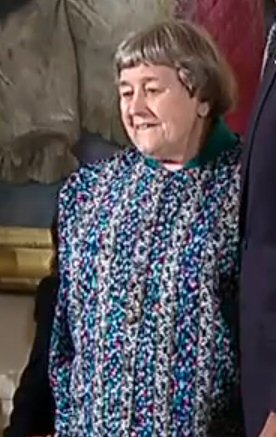Yvonne Brill facts for kids
Quick facts for kids
Yvonne Brill
|
|
|---|---|

Brill in 2011
|
|
| Born |
Yvonne Madalaine Claeys
December 30, 1924 |
| Died | March 27, 2013 (aged 88) |
| Nationality | Canadian/American |
| Alma mater | University of Manitoba, University of Southern California |
| Occupation | Aerospace Engineer Rocket Scientist |
| Awards | AIAA Wyld Propulsion Award (2002) John Fritz Medal (2009) Inducted into the National Inventors Hall of Fame (2010) National Medal of Technology (2010) |
Yvonne Madelaine Brill (née Claeys; December 30, 1924 – March 27, 2013) was a Canadian-American rocket and jet propulsion engineer. She is responsible for inventing the fuel-efficient rocket thruster that keeps satellites in orbit today. During her career she was involved in a broad range of national space programs in the United States, including NASA and the International Maritime Satellite Organization.
Contents
Early life
Brill was born in Winnipeg, Manitoba, Canada. Her parents were immigrants from Belgium, making her and her two siblings first-generation Canadians. While she was in high school, one of her teachers told her that a woman wouldn't get anywhere in science, and her father wanted her to stay at home and open a little shop in town, but she ignored them. She attended the University of Manitoba, but was barred from studying engineering because of her gender, so she studied chemistry and mathematics and graduated at the top of her class in 1945 with a bachelor's degree in both subjects. She went on to study at the University of Southern California, where she took night classes and graduated in 1951 with a master's degree in chemistry.
Career
Brill's work in satellite propulsion systems resulted in a number of significant developments. She developed the concept for a new rocket engine, the hydrazine resistojet, and proposed the use of a single propellant because of the value and simplicity that it would provide. Her invention resulted in not only higher engine performance, but also increased the reliability of the propulsion system. The reduction in propellant weight requirements enabled either increased payload capability or extended mission life.
Brill was believed to be the only woman in the United States researching rocket science in the 1940s. In 1945 she was recruited by Douglas Aircraft despite her lack of a degree in engineering to help develop the first American satellites. She put her career on hold in the 1950s to stay at home and raise her children. Then in 1966 she returned to the field, where she rejoined the Radio Corporation of America (RCA).
Brill invented the hydrazine resistojet propulsion system in 1967, for which she holds U.S. Patent No. 3,807,657. Her invention became a standard in the industry and has translated into millions of dollars of increased revenue for commercial communications satellite owners.
Brill contributed to the propulsion systems of TIROS, the first weather satellite; Nova, a series of rocket designs that were used in American Moon missions; Explorer 32, the first upper-atmosphere satellite; and the Mars Observer, which in 1992 almost entered a Mars orbit before losing communication with Earth.
Awards and honors
Brill was awarded the AIAA Wyld Propulsion Award (2002) and the American Association of Engineering Societies John Fritz Medal (2009). In 1980, Harper's Bazaar and the DeBeers Corporation gave her their Diamond Superwoman award for returning to a successful career after starting a family. In 2001 she was awarded the NASA Distinguished Public Service Medal. In 2010, President Barack Obama presented her with the National Medal of Technology and Innovation. In 2010 she was also inducted into the National Inventors Hall of Fame.
She was elected to the National Academy of Engineering in 1987. She was named fellow of The Society of Women Engineers (SWE) in 1985 and received its highest honor, the Achievement Award, the following year.
The Yvonne C. Brill Lectureship of the American Institute of Aeronautics and Astronautics (AIAA) is named in her honor and presented annually. She spent the last twenty years of her life promoting women in science and engineering and nominated them for awards and prizes she thought they deserved.
Death
A longtime resident of the Skillman section of Montgomery Township, New Jersey, United States, Brill died of complications of breast cancer in Princeton, New Jersey.
An obituary of Brill published in the March 30, 2013 issue of the New York Times originally began: "She made a mean beef stroganoff, followed her husband from job to job and took eight years off from work to raise three children". The obituary was heavily criticized for leading with and overemphasizing Brill's gender and family life, rather than her scientific and career accomplishments and was cited as an example of an article that failed the Finkbeiner test. The Times later dropped the reference to her cooking and changed the lead of the article.
See also
 In Spanish: Yvonne Brill para niños
In Spanish: Yvonne Brill para niños

